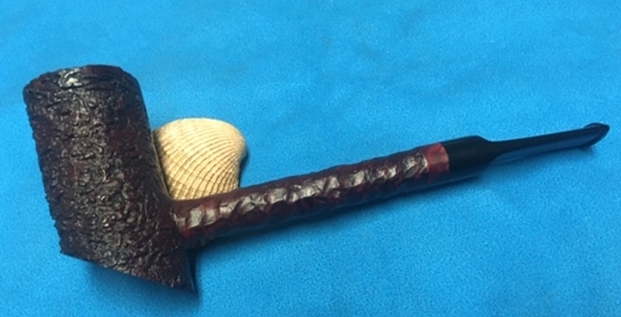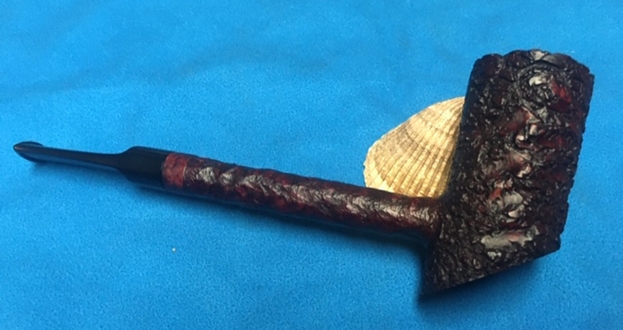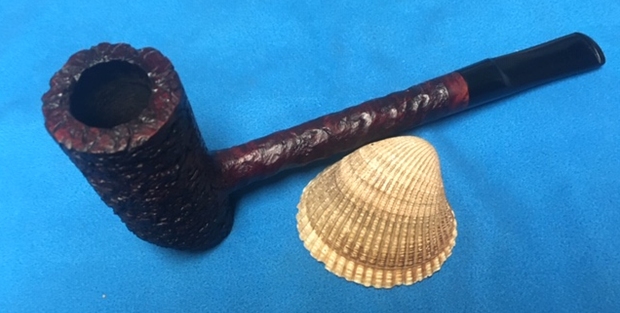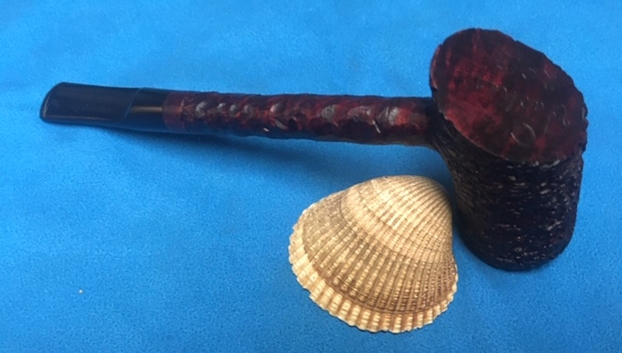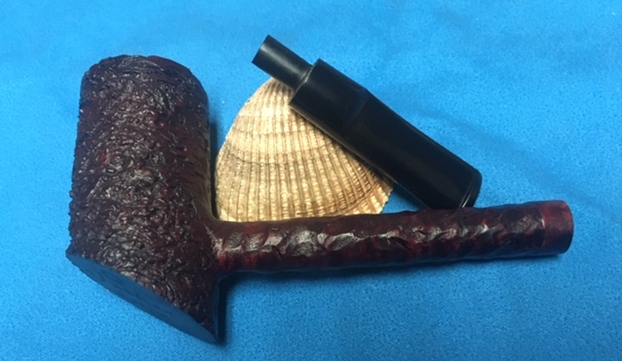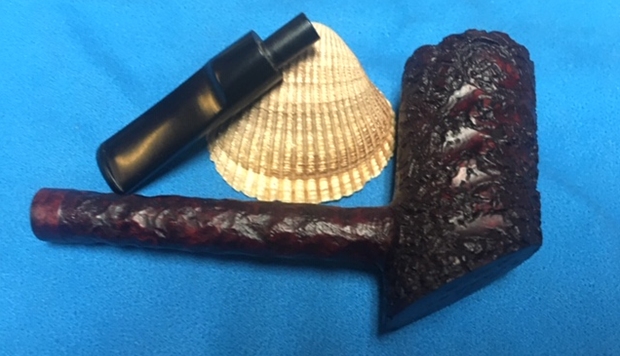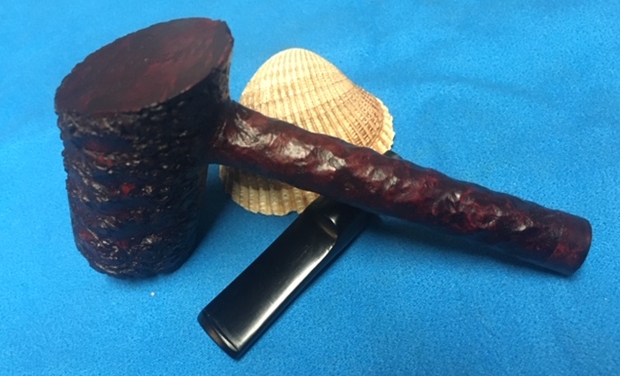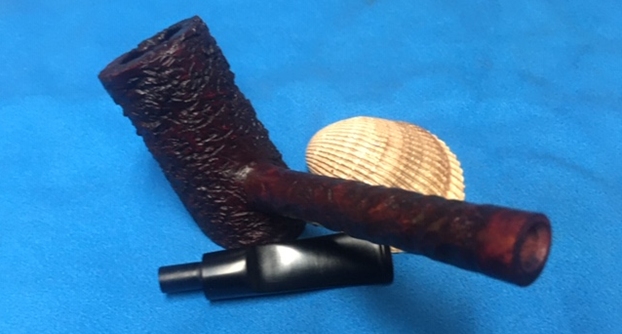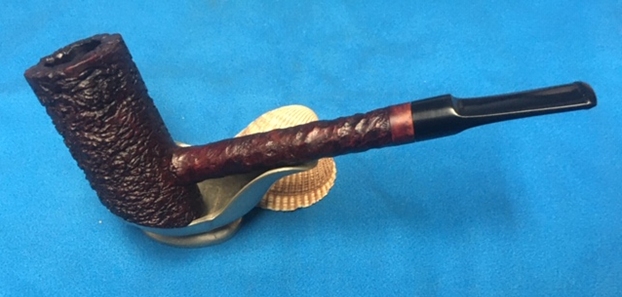Blog by Steve Laug
The next pipe on my worktable is a long shank Cherrywood or Poker. It is a tall pipe with an angled heel that makes it a sitter. It is well balanced so it is a very stable sitter. The finish is a unique mix of rustication patterns. The left side of the bowl (shown in the first photo) is a tight patterned rustication. The right side has some angled grooves across the pattern that is quite unique. The shank rustication is a much looser rustication and again some of the grooves so it is very different from the rest of the bowl. The briar is stain with some black undercoat and an oxblood top coat. The pipe has a smooth heel on the bowl and a smooth band around the shank. The saddle stem is vulcanite that has some light tooth chatter and marks at the button. The bowl has a moderated cake and the inner edge of the rim has some darkening. The rim top itself is quite clean. The stamping is the logo for Laughing Moon Pipes – a crescent moon and a star. Under that is Vacher signature and the number 2013. The pipe is dusty but otherwise in good shape. Jeff took the following photos before he started his cleanup work on the pipe.
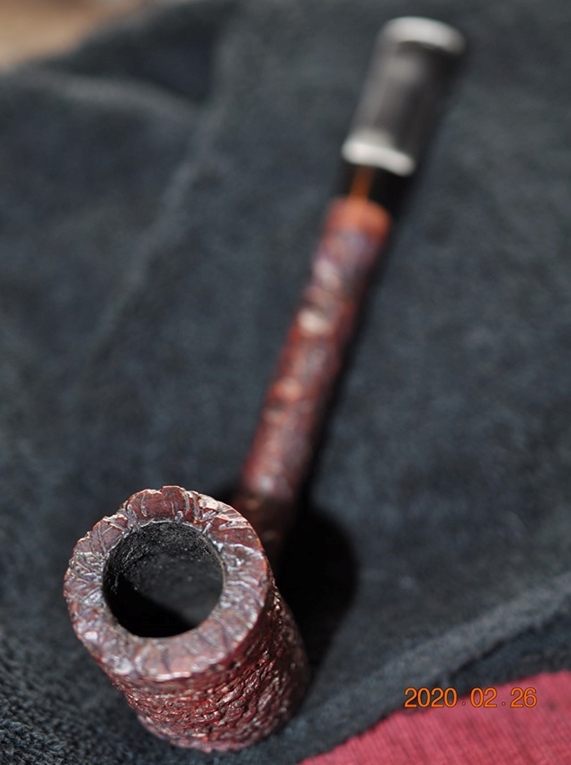 He took close-up photos of the bowl and rim top from various angles to capture the condition of the bowl and rim top edges. You can see the clean rim top free of lava and just a bit dusty. There is also some darkening around the inner edge of the bowl. The rustication on the rim is another different style pattern from the rest of the pipe. Very unique.
He took close-up photos of the bowl and rim top from various angles to capture the condition of the bowl and rim top edges. You can see the clean rim top free of lava and just a bit dusty. There is also some darkening around the inner edge of the bowl. The rustication on the rim is another different style pattern from the rest of the pipe. Very unique.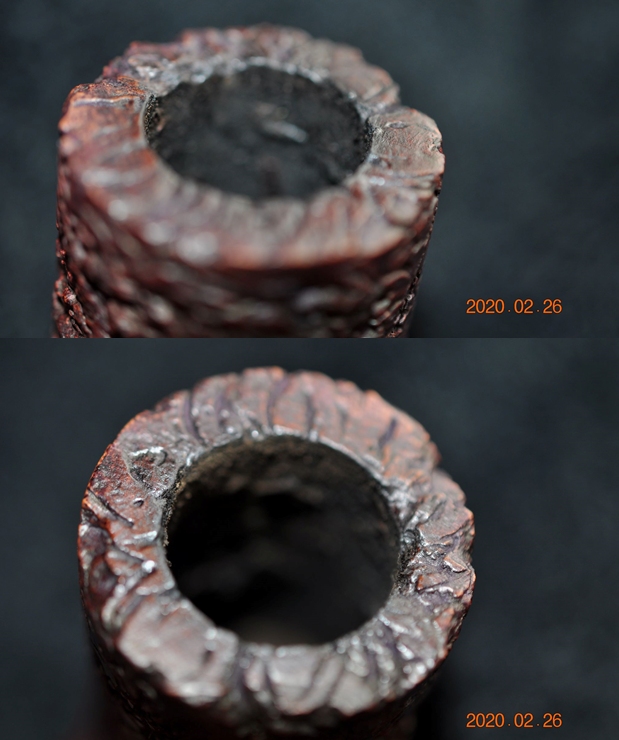 He took photos of the sides and heel of the bowl to show the unique and rugged rustication patterns around the bowl. It is craggy and random looking. You can see the dust and debris in the finish.
He took photos of the sides and heel of the bowl to show the unique and rugged rustication patterns around the bowl. It is craggy and random looking. You can see the dust and debris in the finish.
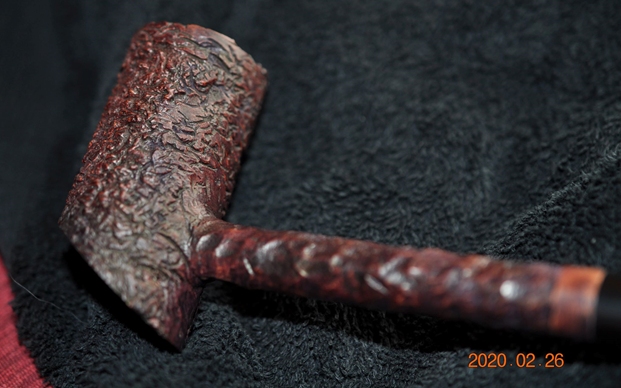
 Jeff took a photo of the stamping on the flat, smooth heel. It has the Laughing Moon Pipes logo at the top and underneath it bears Vacher’s signature and the number 2013 which could be the year of manufacture or something else…
Jeff took a photo of the stamping on the flat, smooth heel. It has the Laughing Moon Pipes logo at the top and underneath it bears Vacher’s signature and the number 2013 which could be the year of manufacture or something else…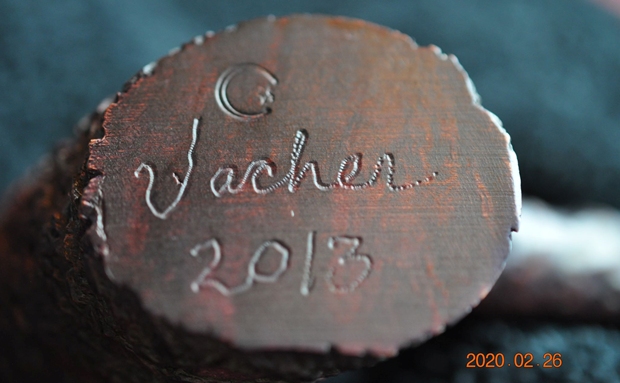 The next two photos show the top and underside of the stem. The oxidation and the tooth marks on both sides near the button are visible in the photos.
The next two photos show the top and underside of the stem. The oxidation and the tooth marks on both sides near the button are visible in the photos.  When the pipe arrived I knew I had worked on pipes from Vacher and Laughing Moon Pipes in the past but I could not find them on the blog. That was strange – maybe age playing a trick on me? Ah well! I instead turned to Pipephil (http://www.pipephil.eu/logos/en/logo-v1.html) to see if he included a quick summary of information on the brand. I was not disappointed. I have included a screen capture of the pertinent section. From there I learned a few things.
When the pipe arrived I knew I had worked on pipes from Vacher and Laughing Moon Pipes in the past but I could not find them on the blog. That was strange – maybe age playing a trick on me? Ah well! I instead turned to Pipephil (http://www.pipephil.eu/logos/en/logo-v1.html) to see if he included a quick summary of information on the brand. I was not disappointed. I have included a screen capture of the pertinent section. From there I learned a few things.
The pipe maker was Robert Vacher who had worked with Brian Ruthenberg in his early days. I also learned that his pipe were stamped with 4 digit numbers. The first 2 digits was the pipe number in the year. The last 2 digits was the year of manufacture. Interestingly that made the pipe on my table the 20th pipe made in 2013 if I am interpreting it correctly. I turned to Pipedia for more information on Robert Vacher and the Laughing Moon Pipes that he carved (https://pipedia.org/wiki/Laughingmoon_Pipes). The site had a great writeup by Vacher himself taken from his Ebay store. The thing that stood out to me was his mission statement which I quote below:
I turned to Pipedia for more information on Robert Vacher and the Laughing Moon Pipes that he carved (https://pipedia.org/wiki/Laughingmoon_Pipes). The site had a great writeup by Vacher himself taken from his Ebay store. The thing that stood out to me was his mission statement which I quote below:
MISSION STATEMENT: I believe that EVERYONE who desires to smoke a handcrafted pipe should be able to buy one regardless of their station in life. There is no reason why the janitor in a highrise should not be able to smoke the same pipe as the owner of that building. My pipes are made for, but not limited to, the people who make up the backbone of this world. The people who get up every day and get the job done. I just want you to know that when I make YOUR pipe, I made it with YOU in mind. So in the future, as in the past, I will make super-affordable pipes for those who enjoy them.
The article also includes the following information on the maker as well as his email address should you desire to contact him.
Robert Vacher
477-700 Laura Lane
Litchfield, California 96117 USA
E-mail: rvacher@citlink.net
Now it was time to look at the pipe up close and personal. I had just finished reworking the dog chewed Ser Jacopo so I was looking for something more like a simple restoration that needed little work. The Vacher appeared to be that pipe . Jeff had done an amazing job in removing all of the cake and the thick lava on the rim top. He had reamed the bowl with a PipNet Pipe Reamer and cleaned up the remnants with a Savinelli Fitsall Pipe Knife. He took the cake back to bare briar so we could check the walls for damage. He scrubbed the exterior of the bowl with Murphy’s Oil Soap and a tooth brush to remove the grime on the bowl and rim and was able to remove the dirt. He cleaned out the interior of the bowl and shank with pipe cleaners, cotton swabs and alcohol until they came out clean. He cleaned the stem with Soft Scrub to remove the grime on the exterior and cleaned out the airway with alcohol, cotton swabs and pipe cleaners. I took some photos of the pipe as I saw it.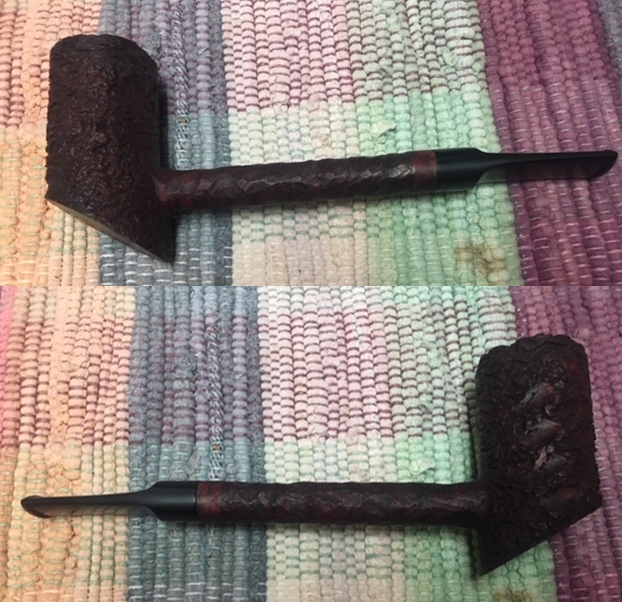
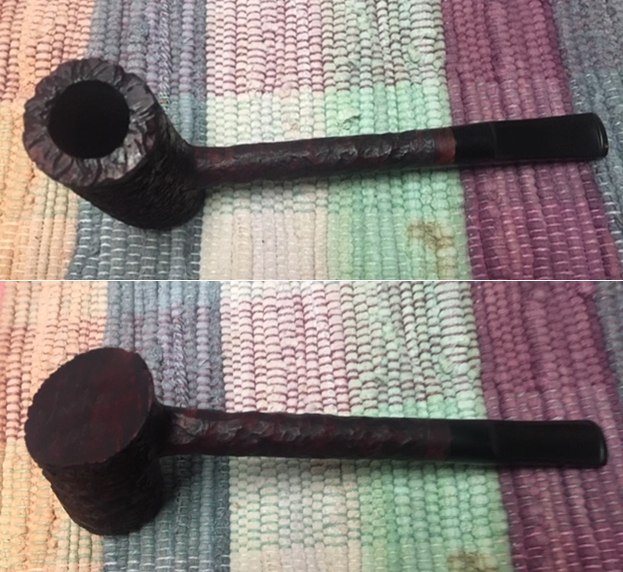 To show how clean the rim top and stem really was I took a close-up photo of the rim and stem. The bowl was clean and cake free. The rim top is very clean with no residual grime in the groves of the rustication. The inner edges of the bowl look good. The black vulcanite saddle stem cleaned up nicely. The surface had some light tooth marks but the button edge looked really good.
To show how clean the rim top and stem really was I took a close-up photo of the rim and stem. The bowl was clean and cake free. The rim top is very clean with no residual grime in the groves of the rustication. The inner edges of the bowl look good. The black vulcanite saddle stem cleaned up nicely. The surface had some light tooth marks but the button edge looked really good.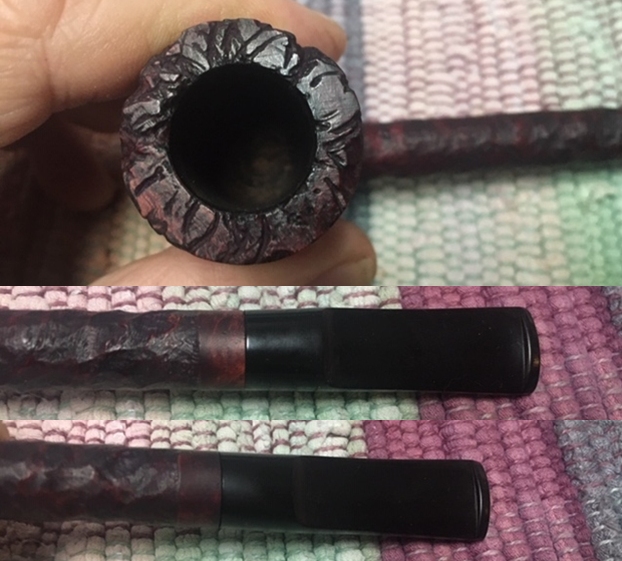 I took a photo of the stamping on the smooth heel of the bowl. You can see the Laughing Moon Pipes logo, Vacher’s name and the numbers.
I took a photo of the stamping on the smooth heel of the bowl. You can see the Laughing Moon Pipes logo, Vacher’s name and the numbers. I removed the stem from the bowl and took photos of the parts. The vulcanite saddle stem worked really well with the thin pencil shank. Take particular note of the stem and tenon in both photos. The distance from the edge of the stem to the side of the tenon is different on both sides. It is definitely narrower on the right and underside which made it clear that the shank drilling was not quite round. I took a photo of the end of the shank and end of the stem to show the same thing. I have identified the thinner side of the shank and stem with red arrows in the 3rd photo below.
I removed the stem from the bowl and took photos of the parts. The vulcanite saddle stem worked really well with the thin pencil shank. Take particular note of the stem and tenon in both photos. The distance from the edge of the stem to the side of the tenon is different on both sides. It is definitely narrower on the right and underside which made it clear that the shank drilling was not quite round. I took a photo of the end of the shank and end of the stem to show the same thing. I have identified the thinner side of the shank and stem with red arrows in the 3rd photo below.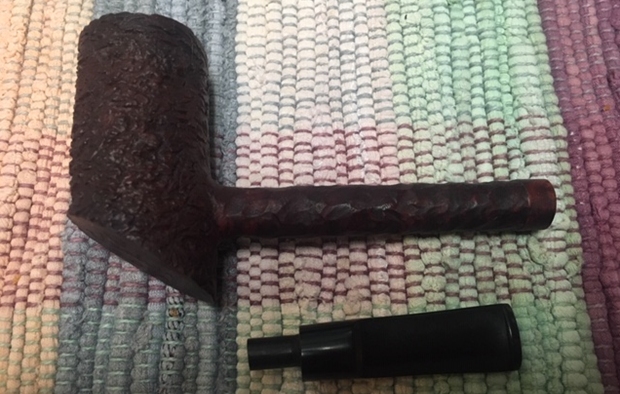
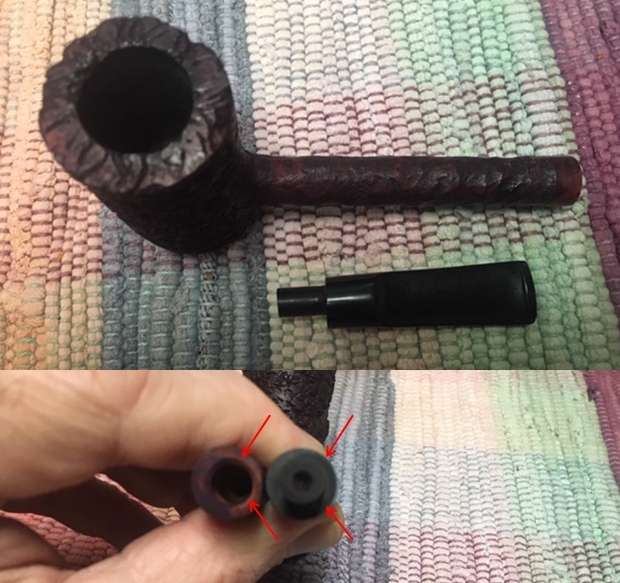 The bowl looked very good so I did not need to do any further work on it. I rubbed the bowl and shank down with Before & After Restoration Balm to deep clean the finish on the bowl and shank. The product works to clean, enliven and protect the briar. I worked it in with my fingers and with a horse hair shoe brush to get it into the deep nooks and crannies of the rusticated finish on the rim and bowl sides. I let it sit for 30 minutes to let it do its magic. I buffed it with a soft cloth. The briar really began to have a rich shine. I took some photos of the bowl at this point to mark the progress in the restoration.
The bowl looked very good so I did not need to do any further work on it. I rubbed the bowl and shank down with Before & After Restoration Balm to deep clean the finish on the bowl and shank. The product works to clean, enliven and protect the briar. I worked it in with my fingers and with a horse hair shoe brush to get it into the deep nooks and crannies of the rusticated finish on the rim and bowl sides. I let it sit for 30 minutes to let it do its magic. I buffed it with a soft cloth. The briar really began to have a rich shine. I took some photos of the bowl at this point to mark the progress in the restoration.
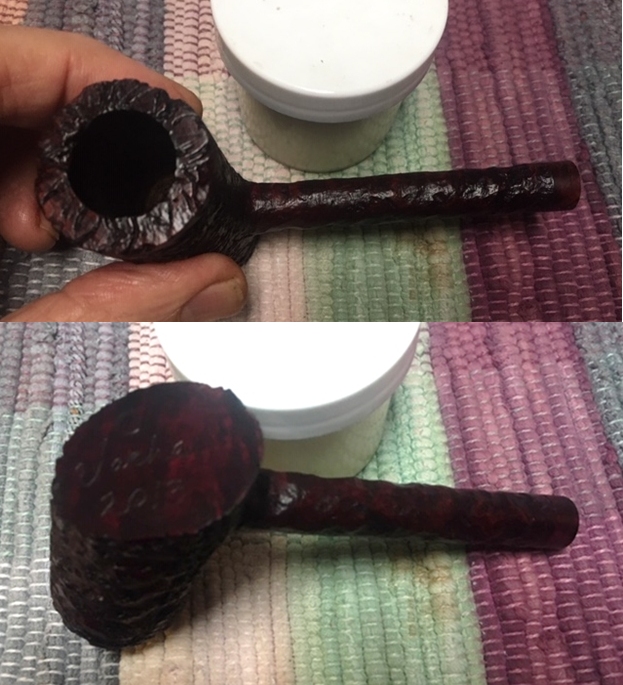
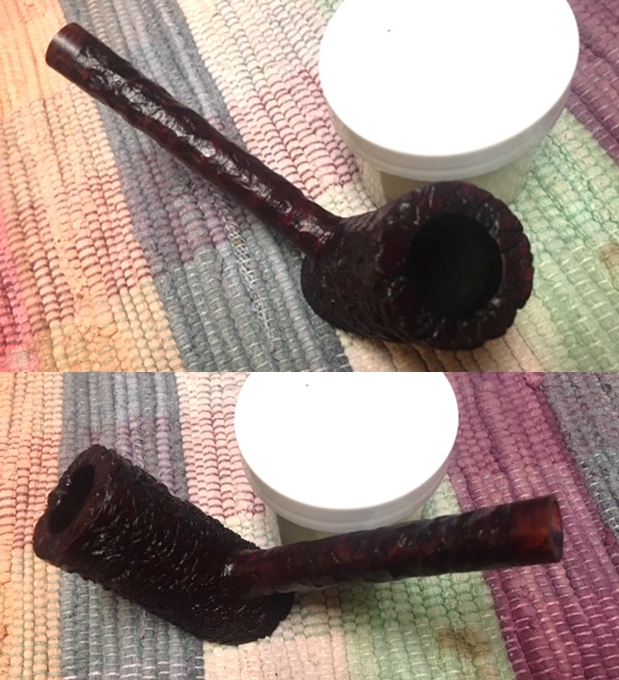 The bowl was finished so I set it aside and turned my attention to the stem. I sanded out the tooth marks on both sides of the stem with a folded piece of 220 sandpaper and started polishing with 400 grit wet dry sandpaper.
The bowl was finished so I set it aside and turned my attention to the stem. I sanded out the tooth marks on both sides of the stem with a folded piece of 220 sandpaper and started polishing with 400 grit wet dry sandpaper. I rubbed the stem down with Denicare Mouthpiece Polish – a red gritty paste a lot like Tripoli to polish it after the 400 grit sandpaper. I rub it on with my fingertips and work it into the vulcanite and buff it off with a cloth. It does a great job before I polish it further with the micromesh pads.
I rubbed the stem down with Denicare Mouthpiece Polish – a red gritty paste a lot like Tripoli to polish it after the 400 grit sandpaper. I rub it on with my fingertips and work it into the vulcanite and buff it off with a cloth. It does a great job before I polish it further with the micromesh pads.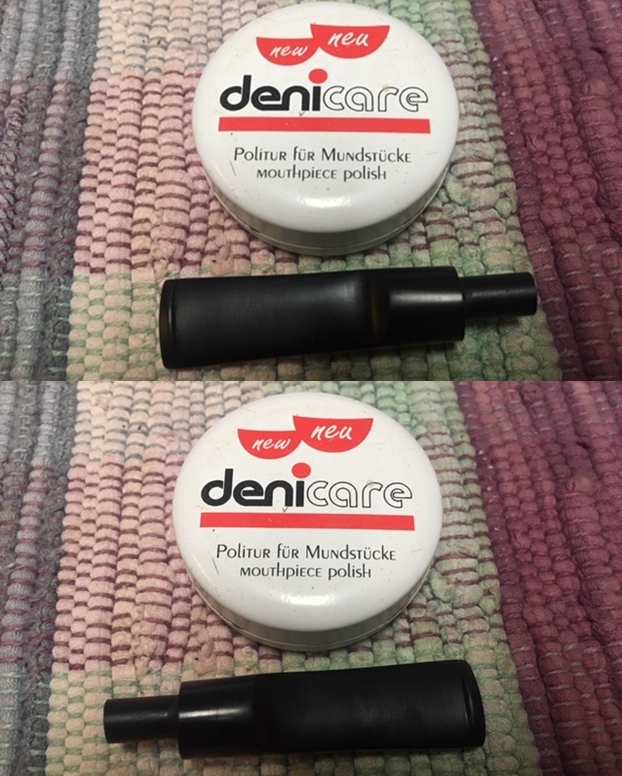 I polished the stem with micromesh sanding pads – dry sanding with 1500-12000 grit sanding pads. I wiped the stem down after each sanding pad with a cloth containing some Obsidian Oil. I finished polishing it with Before & After Pipe Stem Polish – both Fine and Extra Fine and buffed it off with a cotton cloth. I gave it a final rub down with Briarville’s No Oxy Oil to preserve and protect the vulcanite stem.
I polished the stem with micromesh sanding pads – dry sanding with 1500-12000 grit sanding pads. I wiped the stem down after each sanding pad with a cloth containing some Obsidian Oil. I finished polishing it with Before & After Pipe Stem Polish – both Fine and Extra Fine and buffed it off with a cotton cloth. I gave it a final rub down with Briarville’s No Oxy Oil to preserve and protect the vulcanite stem.
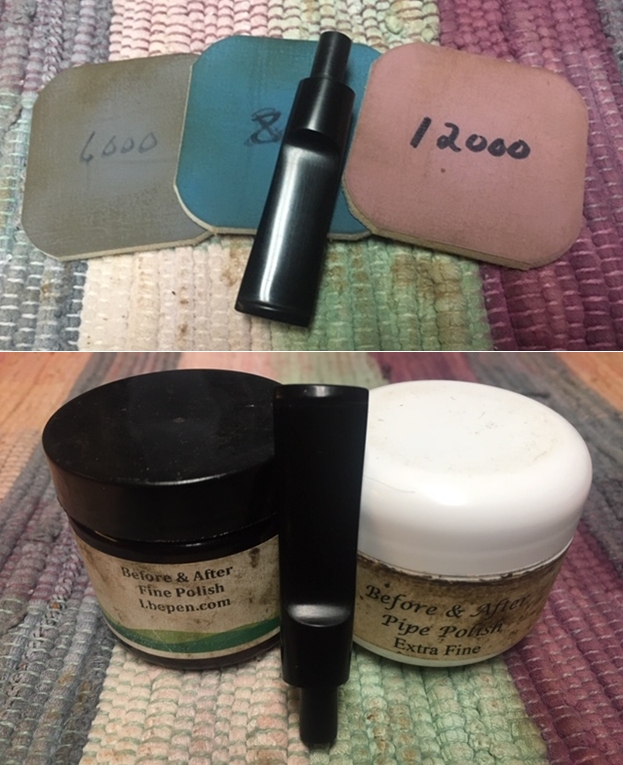
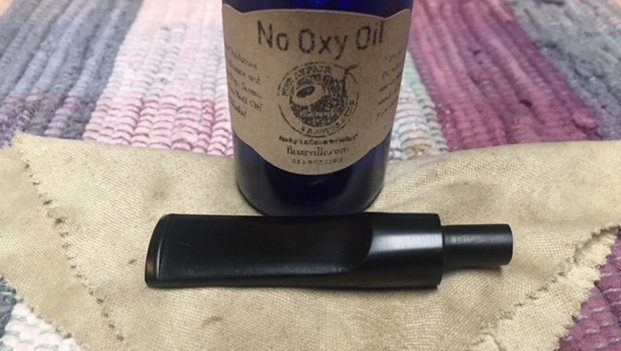 I put the bowl and stem back together again and lightly buffed the bowl and the stem with Blue Diamond on the buffing wheel. I used a soft touch on the rusticated bowl so as not to fill in the valleys and crannies with the product. I gave the bowl several coats of Conservator’s Wax and the stem several coats of carnauba wax. I carefully buffed the entire pipe with a clean buffing pad to raise the shine. I finished buffing with a microfiber cloth to deepen the shine. The finished pipe looks very good. The rusticated finish is deep and rugged with a great look and feel in the hand. It is comfortable and light weight. The finished American Made Vacher is shown in the photos below. The dimensions of the pipe are Length: 6 ½ inches, Height: 2 ½ inches, Outside diameter of the bowl: 1 ¼ inches, Chamber diameter: 5/8 of an inch. This great looking rusticated Cherrywood Poker turned out very well. It should be a great pipe. It will make someone a great smoking pipe. I will be putting it on the rebornpipes store shortly. If you are interested let me know. Thanks for reading this blog and my reflections on the pipe while I worked on it.
I put the bowl and stem back together again and lightly buffed the bowl and the stem with Blue Diamond on the buffing wheel. I used a soft touch on the rusticated bowl so as not to fill in the valleys and crannies with the product. I gave the bowl several coats of Conservator’s Wax and the stem several coats of carnauba wax. I carefully buffed the entire pipe with a clean buffing pad to raise the shine. I finished buffing with a microfiber cloth to deepen the shine. The finished pipe looks very good. The rusticated finish is deep and rugged with a great look and feel in the hand. It is comfortable and light weight. The finished American Made Vacher is shown in the photos below. The dimensions of the pipe are Length: 6 ½ inches, Height: 2 ½ inches, Outside diameter of the bowl: 1 ¼ inches, Chamber diameter: 5/8 of an inch. This great looking rusticated Cherrywood Poker turned out very well. It should be a great pipe. It will make someone a great smoking pipe. I will be putting it on the rebornpipes store shortly. If you are interested let me know. Thanks for reading this blog and my reflections on the pipe while I worked on it.